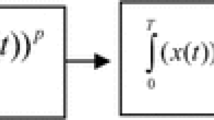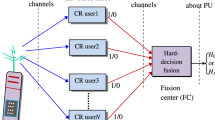Abstract
This paper proposes a novel cooperative spectrum sensing network (CSSN) with improved energy detector (IED) based cognitive radio (CR) users. Every CR user is furnished with multiple antennas (M) and performs itself selection combining (SC) operation. All the CRs sense a primary user (PU) via erroneous sensing channels (S) and send the data to a fusion center (FC) via erroneous reporting channels (R). At FC, decision about PU is evaluated with the assistance of k-out-of-N rule. Detection probability expressions for a CR and FC subject to noise plus Rayleigh/Rician fading are developed. Also both simulation and analytical frameworks for throughput analysis are presented. The analytical performance results are also validated using simulation performance results. Performance comparisons between IED and conventional energy detectors (CED) are presented in terms of throughput and total error rate for several parameter values. Further, overall performance of throughput and total error rate in Rayleigh/Rician fading channels is investigated. The joint effects of diversity and fading on the CSSN throughput is also additionally discussed. Channel error (r) impact on the throughput and total error performances for each proposed and traditional networks is studied. Optimization of several parameters for maximizing the throughput and minimizing the total error is also studied. Throughput overall performance of proposed CSSN is plenty better than the conventional network in each fading channel. For several values of M and r, \(p_{\mathrm{{opt}}}\), \(\lambda _{\mathrm{{n, opt}}}\) and \(N_{\mathrm{{opt}}}\) values are calculated subject to each fading environment. Both analytical and MATLAB simulation results are matched. Under imperfect channel conditions, performances in terms of throughput and total error are not up to the mark but significant performance improvement has been obtained with diversity at each CR level.












Similar content being viewed by others
References
Mitola, J., & Maguire, G. Q. (1999). cognitive radio: Making software radios more personal. IEEE Personal Communications, 6(4), 13–18.
Biglieri, E. (2012).“ An overview of cognitive radio for satellite communications,” In Proceedings of IEEE First AESS European Conference on Satellite Telecommunications (ESTEL), pp. 1–3. Italy, Rome.
Digham, F. F., Alouini, M.-S., & Simon, M. K. (2007). On the energy detection of unknown signals over fading channels. IEEE Transactions on Communications, 55(1), 21–24.
Zheng, M., Chen, L., Liang, W., Yu, H., & Wu, J. (2017). Energy-efficiency maximization for cooperative spectrum sensing in cognitive sensor networks. IEEE Transactions on Green Communications and Networking, 1(1), 29–39.
Ghasemi, A., & Sousa, E. S. (2007). Opportunistic spectrum access in fading channels through collaborative sensing? IEEE Transactions on Wireless Communications, 2(2), 71–82.
Akyildiz, I. F., Lo, B. F., & Balakrishnan, R. (2011). Cooperative spectrum sensing in cognitive radio networks: A survey. Physical Communication, 4(1), 40–62.
Chaudhari, S., Lundn, J., Koivunen, V., & Vincent Poor, H. (2012). Cooperative sensing with imperfect reporting channels: Hard decisions or soft decisions? IEEE Transactions on Signal Processing, 60(1), 18–28.
Liang, Y. C., Zeng, Y., Peh, E. C. Y., & Hoang, A. T. (2008). Sensing-throughput tradeoff for cognitive radio networks. IEEE Transactions on Wireless Communications, 7(4), 1326–1337.
Peh, E. C. Y., Liang, Y. C., Guan, Y. L., & Zeng, Y. (2009). Optimization of cooperative sensing in cognitive radio networks: A sensing-throughput tradeoff view. IEEE Transactions on Vehicular Technology, 58(9), 5294–5299.
Singh, A., Bhatnagar, M. R., & Mallik, R. K. (2012). Cooperative spectrum sensing in multiple antenna based cognitive radio network using an improved energy detector. IEEE Communications Letters, 16(1), 64–67.
Nallagonda, S., Chandra, A., Roy, S. D., & Kundu, S. (2013). On performance of cooperative spectrum sensing based on improved energy detector with multiple antennas in Hoyt fading channel, In Proceedings in I. I. T. Bombay (Ed.), of annual IEEE India conference (INDICON), India. pp. 1–6.
Nallagonda, S., Chandra, A., Roy, S. D., & Kundu, S. (2013). Detection performance of cooperative spectrum sensing over Hoyt and Rican faded sensing channels. IEICE Communications Express (ComEx), 2(7), 319–324.
Balam, S. K., Siddaiah, P., & Nallagonda, S. (2018). Throughput analysis of cooperative cognitive radio network over generalized \(\kappa -\mu \) and \(\eta -\mu \). Wireless Networks. https://doi.org/10.1007/s11276-018-1758-4.
Ranjeeth, M., & Anuradha, S. (Feb. 2019). “Throughput analysis in cooperative spectrum sensing network using an improved energy detector,” In Proceedings of 21st International conference on advanced communication technology, Korea, pp. 483–487.
Ranjeeth, M., & Anuradha, S. (2018). Throughput analysis in proposed cooperative spectrum sensing network with an improved energy detector scheme over Rayleigh fading channel. AEU - International Journal of Electronics and Communications, 83, 416–426.
Yadav, K., Ro, S. D., & Kundu, S. (2018). Throughput of cognitive radio networks with improved energy detector under security threats. International Journal of Communication Systems, 31(6), e3512.
Alnwaimi, G., & Boujemaa, H. (2019). “Instantaneous throughput maximization for cognitive radio networks,” In Proceedings of international wireless communications and mobile computing conference (IWCMC), Tangier, Morocco, pp. 192–196.
Santhoshkumar, M., & Premkumar, K. (2020). “Energy-throughput tradeoff with optimal sensing order in cognitive radio networks,” In Proceedings of International conference on communication systems and networks (COMSNETS), pp. 1–8. Bengaluru, India.
Simon, M. K., & Alouini, M. S. (2004). Digital communication over fading channels (2nd ed.). NJ, USA: John Wiley and Sons.
Chandra, A., Bose, C., & Bose, M. K. (2012). Symbol error probability of non-coherent \(M\)-ary frequency shift keying with postdetection selection and switched combining over Hoyt fading channel. IET Communications, 6(12), 1692–1701.
Althunibat, S., & Granelli, F. (2014). “Energy efficiency analysis of soft and hard cooperative spectrum sensing schemes in cognitive radio networks,” IEEE 79th vehicular technology conference (VTC Spring), pp. 1–5, Seoul.
Nallagonda, S., Ranjeeth, M., & Bhowmick, A. (2021). Analysis of energy-efficient cooperative spectrum sensing with improved energy detectors and multiple antennas over Nakagami-\(q/n\) fading channels. International Journal of Communication Systems, 35(5), e3512.
Van Trees, H. L. (1968). Detection, estimation, and modulation theory-part 1. New York: Wiley.
Nuttall, A. H. (1975). Some integrals involving the QM function. IEEE Transactions on Information Theory, 21(1), 95–96.
Marcum, J. I. (1947). A statistical theory of target detection by pulsed radar, Air force project RAND research memorandum RM-754 (pp. 159–160). Santa Monica: Rand Corporation.
Banavathu, N. R., & Khan, M. Z. A. (2016). On the throughput maximization of cognitive radio using cooperative spectrum sensing over erroneous control channel, In Proceedings of IEEE national conference on communication (NCC), pp. 1–6. India: IIT Guwahati.
Author information
Authors and Affiliations
Corresponding author
Additional information
Publisher's Note
Springer Nature remains neutral with regard to jurisdictional claims in published maps and institutional affiliations.
Rights and permissions
About this article
Cite this article
Nallagonda, S., Bhowmick, A. & Prasad, B. Throughput performance of cooperative spectrum sensing network with improved energy detectors and SC diversity over fading channels. Wireless Netw 27, 4039–4050 (2021). https://doi.org/10.1007/s11276-021-02685-0
Accepted:
Published:
Issue Date:
DOI: https://doi.org/10.1007/s11276-021-02685-0




